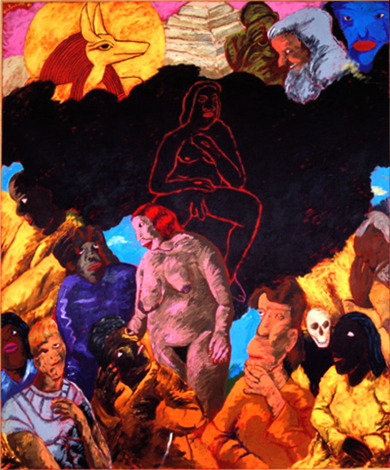
Robert Colescott
(American, 1925–2009)
Knowledge of the Past Is the Key to the Future: Some Afterthoughts on Discovery
Metropolitan Museum of Art New York
Date: 1986
Medium: Acrylic on canvas
Dimensions: 90 x 114in. (228.6 x 289.6cm)
Classification: Paintings
Credit Line: Arthur Hoppock Hearn Fund, 1987
Accession Number: 1987.166
About:
June 10, 2009
Robert Colescott, Painter Who Toyed With Race and Sex, Dies at 83
By ROBERTA SMITH
Robert Colescott, an American figurative painter whose garishly powerful canvases lampooned racial and sexual stereotypes with rakish imagery, lurid colors and almost tangible glee, died Thursday at his home in Tucson. He was 83.
 April in Paris, 1988.
April in Paris, 1988.
His death was confirmed by his wife, Jandava Cattron, who said he had suffered for several years from Parkinsonian syndrome.
Mr. Colescott represented the United States at the Venice Biennale in 1997, the first African-American to do so. By then he was well known for pitting the painterly against the political to create giddily joyful, destabilized compositions that satirized, and offended, without regard to race, creed, gender or political leaning.
People of all colors haunt Mr. Colescott’s paintings, mostly as chimerical stereotypes that exchange attributes freely. Their mottled skin tones often suggest one race seeping through another. Their tumultuous interactions evoke a volatile mixture of suspicion, desire, pain and vitality. His slurred shapes, wobbly drawing and patchy brushwork imply that no truths can be held to be self-evident, that life is mired in slippery layers of false piety, self-interest and greed, but also lust, pleasure and irreverence.
 Auvers sur Oise, Crowin the Wheatfield, 1981.
Auvers sur Oise, Crowin the Wheatfield, 1981.
Steeped in history and art history, Mr. Colescott often found new uses and meanings for the landmarks of Western painting, borrowing compositions and characters from van Eyck, Goya and Manet and peppering his scenes with the Africanized faces from Picasso’s “Demoiselles d’Avignon.”
In “George Washington Carver Crossing the Delaware: Page From an American History Textbook,” from 1975, he reinterpreted Emmanuel Leutze’s famous painting of George Washington during the American Revolution with Carver at the center, accompanied by black cooks, Aunt Jemimas and banjo players. “Eat Dem Taters” another painting from 1975, substituted laughing black people for the pious Dutch peasants of van Gogh’s “Potato Eaters” to attack, in his words, “the myth of the happy darky.” No American painter of the late 20th century made such telling use of painting’s European past to lambaste the painful contradictions of the American present.
 Emergency Room, 1989.
Emergency Room, 1989.
Mr. Colescott’s work anticipated the appropriation art and Neo-Expressionist painting of the 1980s. His imagery shared aspects with Pop Art, although he disdained its coolness. His improvisational approach had precedents in jazz and Abstract Expressionism. He said he wanted his surface to “squirm.”
Mr. Colescott was born in Oakland, Calif., on Aug. 26, 1925. His mother, a pianist, and his father, a jazz violinist who supported the family as a porter on the Southern Pacific Railroad, had moved to California from New Orleans in 1919 to improve their children’s chances for a good education.
 Sunset on the Bayou, 1993.
Sunset on the Bayou, 1993.
He grew up playing the drums and always kept a drum kit in his studio. But he also drew and painted from childhood. The African-American sculptor Sargent Johnson, who worked with Mr. Colescott’s father on the Southern Pacific, was a family friend.
After serving with the Army in France and Germany during World War II, Mr. Colescott majored in art at the University of California, Berkeley, emerging in 1949 with a bachelor’s degree in painting and a geometric abstract style. During a year in Paris he studied with the painter Fernand Léger — whose emphasis on scale, color and narration made a lasting impression — and spent a lot of time in museums, looking at 19th-century painting. He returned to Berkeley for a master’s and spent the next decade teaching in the Northwest.
In 1964, a teaching residency took him to Cairo, where Egyptian art reiterated for him Léger’s ideas about narrative, but from outside the Western canon. After another stint in Paris he returned in 1967 to the United States, which he found changed by the civil rights movement, and to the Bay Area, where artists like Roy De Forest, William T. Wiley, Joan Brown, Robert Arneson and especially Peter Saul had developed extravagant, often caustic figurative styles. By the end of the 1960s he had found his mature style.
 Second Thoughts on Eternity, 1991.
Second Thoughts on Eternity, 1991.
Mr. Colescott’s first four marriages ended in divorce. He is survived by his wife, Ms. Cattron; his brother, Warrington Colescott Jr., of Hollandale, Wis.; five sons from previous marriages — Alexander, of Napa, Calif.; Nicolas, of Portland, Ore.; Dennett, of San Rafael, Calif.; Daniel, of Modesto, Calif.; and Cooper, of Tucson — and one grandson.
While Mr. Colescott’s work was overtly political and multicultural, it was often at odds with the academic earnestness of such approaches. In his disregard for simplistic dualities regarding race and sex , he helped set the stage for transgressive work by painters like Ellen Gallagher, Kerry James Marshall, Sue Williams and Carroll Dunham and multimedia artists like Kara Walker, William Pope.L and Kalup Linzy.
When asked if he didn’t feel an obligation to serve “the black community,” Mr. Colescott replied, “The way that one serves is to serve art first,” adding that “the way you serve art is by being true to yourself.”
Copyright 2009 The New York Times Company
